Quadrature Z
A New Kind of Amplifier
The design of the Berning ZH270 power amplifier represented a radical departure from that of other amplifiers. The ZH270 was the first amplifier using all-tube amplification to properly match the high-voltage, low-current operating parameters of vacuum tubes to the low-voltage, high-current drive requirements of dynamic loudspeakers without using audio-output transformers. The technology is detailed in Berning US patent 5,612,646, and a simplified overview is given below. The ZH270 has gained much respect for its transparency, versatility, and reliability, and has enjoyed a production run of over 10 years. The ZH technology has also proven itself in other recent Berning products as well.
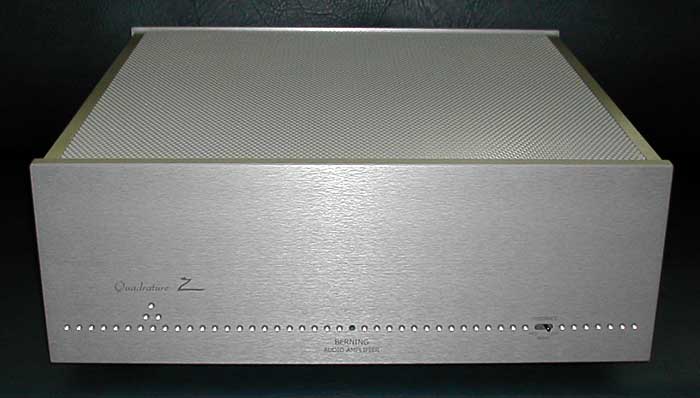
The Quadrature Z applies the ZH technology to a higher power application, and in particular higher output current capability. The term "quadrature" refers to the interleaving of the impedance conversion process in that parallel impedance conversions are taking place with phase overlap so that all conversion dead time is eliminated. This means that the coupling between the output tubes and the speaker in the Quadrature Z is much tighter than it is with the previous ZH products. The impedance conversion in the Quadrature Z requires doubling the number of parts that are normally needed, and thus only the most demanding applications can justify the additional cost.
Motivation for the Berning Technology
Audio-amplifier design engineers have long sought to eliminate the audio-output transformer because of the restrictions that it has always imposed on amplifier performance. Both leakage inductance and interwinding capacitance limit the high-frequency response of the transformer, while core saturation and magnetizing current limit its low-frequency response. Transformer-core hysteresis causes certain kinds of distortion of the non-symmetric and transient waveforms so characteristic of musical reproduction.
Tube Amplifiers have been previously made that drive dynamic loudspeakers without output transformers. These amplifiers are called output-transformerless (OTL) amplifiers. A well-known pioneer of this type of amplifier was Julius Futterman, and there have been many amplifiers made by various companies over the years that are based on the Futterman principles. The Futterman design incorporates two separate banks of parallel-connected tubes. The two banks are joined in series by connecting the effective cathode of one tube bank to the effective plate of the other tube bank, and driving the loudspeaker in a push-pull fashion from this junction point directly without a transformer. Popular alternatives to the Futterman use low-impedance triodes, but the basic principals are the same. Given a sufficient number of parallel-connected tubes in each bank, enough drive current can be obtained to drive the speaker.
There are several problems associated with the OTL amplifier that have limited its application. The OTL amplifier is a "brute-force" methodology, whereby the banks of tubes are forced to deliver the required drive-current by high-feedback techniques. The natural impedance of the cathode "push" is much lower than the plate "pull", and neither one is anywhere near the actual speaker impedance. In the Futterman amplifier, a large amount of negative feedback is required to force the push and the pull to work together properly, and to provide sufficient damping for the speaker. Some of the alternative OTLs that use the low-impedance triodes can operate without requiring feedback because the gain of these triodes is so low that there is little difference between the plate impedance and the cathode impedance, so the mismatch between the push and the pull is minimal. However, even with the lowest impedance triodes available, there is still a basic impedance mismatch between the tubes and the speaker in the OTL circuit. The success of mating OTL amplifiers to dynamic speakers is very dependent on the characteristics of individual speakers.
Major reliability issues surround OTL amplifiers, not only because a large number of power tubes are required, but also it is necessary that the tubes need to be driven hard to obtain the required output current. Power consumption is high for OTL amplifiers, often exceeding one kilowatt for a stereo pair. Noisy fans may be needed in these amplifiers. Additional room air-conditioning may be needed, further increasing the listening-room noise level. Some OTL users promote the use of autoformers to match the impedance of these amplifiers, but this is not much different than having an output transformer on the amplifier in the first place.

The Berning ZH amplifiers take advantage of new technology in order to eliminate the audio-output transformer. These amplifiers use radio frequency to change the voltage-current transfer characteristics of the output tubes from their normal impedance-plane to one suitable for driving a dynamic loudspeaker. The radio frequency re-mapping is implemented using special high-frequency power conversion techniques. The high-voltage, low-current tube impedance-plane is re-mapped to the high-current speaker impedance-plane through a special transformer at a constant RF carrier frequency of 250 kHz. Because the audio signal is riding on a carrier, it is not subject to parasitic elements of the transformer that would otherwise distort the audio signal. There is no low-frequency limit for this impedance conversion, and these amplifiers are dc-coupled, with the exception of a small, high-quality, dc-blocking capacitor at the input of the amplifier to prevent the amplification and application to the speaker of any dc that might be present at the input.
The impedance matching in the ZH amplifier is precisely determined by the effective turns ratio of the RF conversion transformers. Both the push and pull portions of the amplifier are handled in a symmetric fashion, as they are in a conventional transformer-coupled amplifier, and negative feedback is not required to force the positive-output current capability to be similar to the negative-output current capability.
Audio-output transformers have a limited impedance conversion range imposed by the parasitic elements. Audio-output transformers also have limits imposed by voltage breakdown between primary and secondary, and required insulation also affects the parasitic elements adversely. It is difficult to make a high-fidelity transformer with much more than a 25:1 overall primary-to-secondary turns ratio for the above reasons. These restrictions are eliminated in the ZH amplifiers, and larger effective overall turns ratios are applied to use the tubes more efficiently than they can be with the smaller ratios. One implication of this change is that the reflected plate resistance of the output tubes is lowered, making the tubes appear more like triodes to the speaker. The Quadrature Z, like the ZH270, uses a special triode-connected screen-drive arrangement (Berning patent no. 3,995,226) that offers greatly enhanced reliability and also improved linearity at low idle currents.
Another implication of using a higher-effective turns ratio is that the output tubes operate at lower current and higher voltage than they otherwise would. As tubes become weak with age, the current capability is reduced, but the voltage capability is not affected. Longer useful tube life is expected because less current is required for a given output power. The opposite situation applies to the traditional OTL amplifier.
The higher effective-turns ratio also means that distortion is reduced for a given amount of negative feedback because the current loading of the output tubes is reduced. The higher-voltage, lower-current tube operation afforded by the higher effective-turns ratio operates the tubes with sufficient efficiency so that the Quadrature Z can deliver high power with only four modest-sized output tubes.
Audio-output transformer-coupled amplifiers should not be operated without a load connected because the inductance of the transformer's primary can cause the plate voltage to reach a sufficiently high voltage to break down insulating materials, resulting in amplifier failure and even fire. Some amplifiers are even unstable without a load. Unlike output-transformer-coupled amplifiers, the ZH amplifiers can be operated safely without a load, as the voltage cannot exceed its normal designed-in operating voltage.
Other Features and Specifications
Like other recent Berning products, the Quadrature Z incorporates a fully regulated, resonant-type, switching power supply. The use of regulated switching power-supplies in Berning amplifiers over the years has resulted in these amplifiers obtaining a reputation for having better control in the bass than tube amplifiers with conventional power supplies. The use of these supplies has also resulted in unusually lightweight and compact amplifiers for their power capability because there was no line-frequency power-transformer in these units. Some people with traditional ideas found it difficult to believe that improved bass reproduction could be obtained with a lighter-weight design.
The Quadrature Z follows other Berning designs in that the tubes are operated at relatively low temperatures for long life. The idle plate-dissipation for the 33JV6 output tubes is seven watts each, and their heaters are operated below their normal rated voltage. Routine tube replacement on the Quadrature Z should not be needed with normal usage, and 20,000 hour lifetime should be expected. The Quadrature Z incorporates an extremely sophisticated auto-biasing circuitry that uses fast sample and hold techniques to measure and automatically adjust the tube bias for all tubes, thus eliminating the need for the user to make any type of calibration adjustments. In fact, there are no calibration adjustments in the amplifier. This auto-bias circuit is linked to the power supply, in that if a defective tube prevents proper biasing, the power supply is cut back to prevent the defective tube from causing other component failures and speaker damage.
The audio circuit board in the Quadrature Z is a special low-loss ceramic material and provides for the amplifier having a more transparent sound with additional presence.
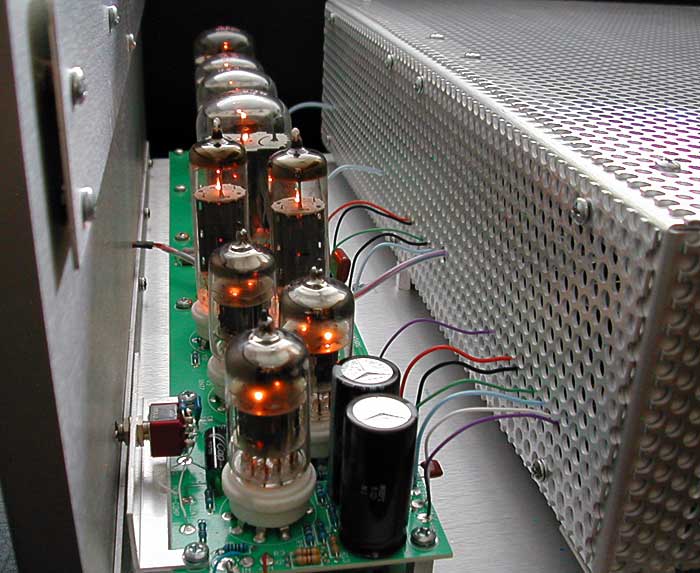
A three-position feedback switch is included on the Quadrature Z. The "NORM" position provides about 12 dB of feedback with an eight-ohm speaker load, while the "MED" position and the "LOW" position provide about 7 dB and 3 dB respectively. The most significant effects of this switch are to change both the output impedance and the speaker damping. While many amplifiers have greater than 12 dB of negative feedback and high damping, this is not always optimum. The impedance of many speakers varies with frequency, and often this shows up most dramatically with a rise in impedance near the bass resonance frequency. The feedback switch can be used to reduce the feedback and thus raise the output impedance of the amplifier, and this affects the system frequency balance by coupling more power into the speaker at those frequencies where the impedance is higher. Speaker designers generally try to design for a flat frequency response using an anechoic chamber. Home listening environments generally fall far short of the ideal acoustic properties of the anechoic chamber, and the feedback switch gives you, the amplifier user, a means to modify the normal speaker response to compensate for room acoustics and personal preference.
Technically, speaker damping relates to the control that the amplifier has over the position of the speaker diaphragm. High damping applies tighter voltage control over the speaker and causes the amplifier to absorb and stop speaker cone motion due to the speaker cone overshooting its desired position in response to transients. However, many speakers are somewhat over damped by design and rigid voltage control is not optimum. A lower feedback setting on the amplifier reduces the tightness of the voltage control and applies a mixture of current and voltage control. If the speaker is over damped, the cone will not reach its proper position quickly in response to a transient. With the right amount of damping, the speaker cone will neither overshoot nor undershoot its desired position. This is often termed critical damping. High damping is likely to give a tighter, dryer, and more analytical sound, and low damping is likely to give a more open and resonant sound. The sonic attributes of damping show up most dramatically in the bass.
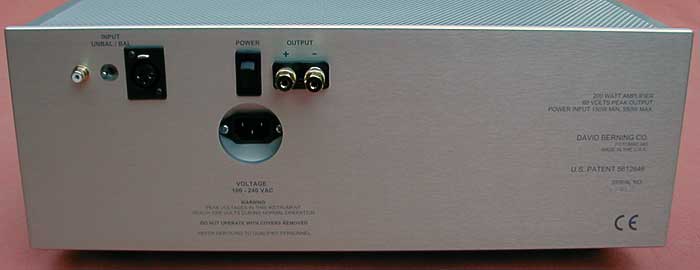
Other features and specifications include:
- Both single and balanced input, all balanced amplification.
- Special triode-like screen-drive output stage.
- Low negative feedback, no phase compensation used.
- Constant output impedance over entire audio spectrum.
- Built-in five-stage power-line filter and surge suppressor.
- Non-magnetic chassis prevents skin-effect induced distortion.
- Separate shielded enclosure for power supply reduces noise.
- Power consumption: idle-125 W; max-500 W. Power factor corrected.
- Line voltage required: 100-260 VAC, 50-440 Hz.
- Signal to noise: broadband (typical) 55 dB, all feedback settings. 20 kHz bandwidth (typical): 98 dB, NORM feedback; 92 dB, MED feedback; 86 dB, LOW feedback. All figures unweighted.
- Distortion (typical, at 8 ohm loads at 200 W): 0.3%, NORM feedback; 0.5%, MED feedback; 1%, LOW feedback. These double at 4 ohms.
- Typical output power at onset of clipping: 8 ohms 220 W; 4 ohms 270W.
- Frequency response at 5 W, 8 ohms; +0, -3 dB: 2 Hz to 90 kHz, NORM feedback; 2 Hz to 60 kHz, MED feedback; 2 Hz to 40 kHz, LOW feedback.
- Frequency response at 5 W, 4 ohms; +0, -3 dB: 2 Hz to 50 kHz, NORM feedback; 2 Hz to 40 kHz, MED feedback; 2 Hz to 30 kHz, LOW feedback.
- Full power bandwidth (-3 dB), 4 ohms: 20 Hz to 50 kHz, NORM feedback; 20 Hz to 36 kHz, LOW feedback. Low frequency bandwidth limit intentionally set by speaker protection (0dB down at 20 Hz).
- Typical output impedance (measured at 1 amp, 60 Hz): 0.8 ohms, NORM feedback; 2 ohms, MED feedback; 5 ohms, LOW feedback.
- Sensitivity, 200 W, 8 ohms: 1V, single-ended input. Feedback gain compensated.
- Input impedance: 35 k -50 k, depending on feedback setting, both single-ended and balanced inputs.
- Tube complement: (4) 33JV6 output; (2) 16GK6 driver; (3) 12AT7 input and gain.
- Size: 48 cm wide, 48 cm deep, 20 cm high, (19 X 19 X 8 inches), including connectors and feet.
- Net weight: 15 kg (32 lb); Boxed, 17 kg (38 lb).
- Finish: silver face and back anodized aluminum; top and sides: light gray paint with silver anodized accent bars. Also available in black anodized aluminum by special order.
- Comes equipped with Stillpoints TM isolation feet.
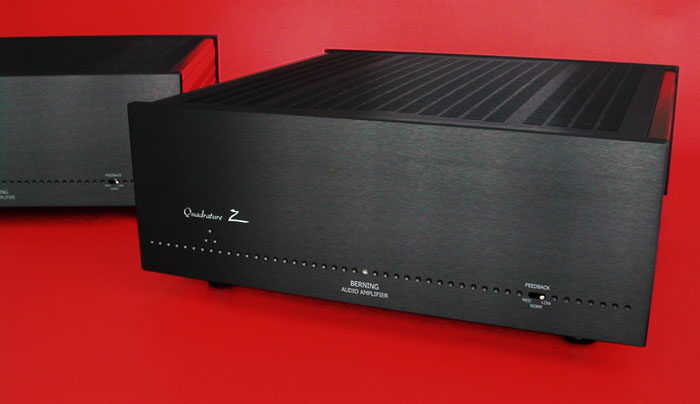
Quadrature-Z Reviews
Quadrature Z is Hi-Fi+ Magazine's Power Amp of the Year 2009
Issue 68, 2009 [PDF]
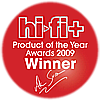
Quadrature Z follow-up by Roy Gregory, editor of Hi-Fi+ Magazine
Issue 61, November 2008 [PDF] "The more time you spend with them the more insight you gain, but one of the things that kept ramming itself home when I was trying to get to the bottom of why they are so special is the moments of transition between notes -- and I don't limit this to just the way that leading edges are dealt with. That special moment of birth as a new note grows over the decay of what went before is just one area where the Bernings are so compelling and so real." "The first time I fired them up I was not expecting too much for the first hour or so and expected to leave them gently cooking on CD repeat while I did other things. But they hooked me from the first few bars of music, and that's when I realized I was dealing with something quite different and special." "...the Quadrature Z amplifiers will shake your preconceptions to the core. They'll open your ears to the sheer beauty of music." "You think you have heard uncompressed, colourful texture coupled with serious power? And do you know how far reaching the term resolution can really be? I thought I had a pretty good idea of these things, but the Quadrature Z has redefined my notion of what a power amplifier can do. To speak of it in terms of grip, bass weight, bandwidth and detail is meaningless and if you judge equipment at this level by those yardsticks then you will find that you (like me) need to rethink a whole new vocabulary to describe these amplifiers." "[The Quadrature Z] has the distinction of being not only the fastest power amplifier I have ever heard but also the amplifier that makes no show of the fact by over accentuating the leading edge of the note or the percussive element that marks the beat." "I had many listening hours with these amplifiers that bordered on the spiritual...breathless and hanging on each tiny rhythmic paraphrase. This is where great hi-fi should take you." "These amplifiers are one of the very, very few products whose performance is completely music-led, making it very difficult to describe in hi-fi terms." "...I point the finger across the Atlantic at David Berning of Maryland in the USA, as it is his monobloc amplifiers that have had me totally hooked and continually capture my musical fascination in a way that so few products ever have." "[Herbie] Hancock's piano is confident and wonderful as he shows us what real touch sensitivity is. There is a stillness at the heart of his playing, as if he is feeling out and shaping each note. Every small change in pressure, every carefully crafted tonal colour is an extension of his sensitivity -- and the piano, with its ten billion possibilities, is his instrument of expression. The Bernings take you there, right to his fingertips, to the hammer on the string and to the colourful harmonic signature of the piano as a whole. They are marvelously commanding and confident in the way that they allow the instruments to breathe the fundamentals and harmonics with no trace of system artifice to get in the way and have a clarity against a background of silence that is, in my experience, unique." "The Bernings are utterly articulate when dealing with music and as fast as they need to be for any given music situation. You will never, ever hear these amplifiers smear time or tempo." "Regardless of what level of performance you are used to you will be amazed at the purity of musical energy available. At two hundreds watts per channel the [Quadrature Z] amplifiers have power in abundance, but this is no Tsunami of sheer volume, as they employ it with discretion and quite breahtaking vitality at whatever level you require. I have never heard a soundstage so animated and alive with dynamic movement. The music appears in the room with a freedom that really needs to be experienced to be appreciated. It certainly makes so much other high-end amplification sound over-damped, electronically reconstructed and it has to be said, contrived. I actually found myself listening at lower levels than usual for much of the time as the Quadrature Z maintains its stellar performance and uncanny stability regardless." "...the Berning amplifiers never lose focus or a single strand for a moment. The music just draws you further and further in." "With these amplifiers the music is the message and the method of delivery is awesome." "[The Quadrature Z amplifiers] bring no preformed view of the musical picture and do not impose their view of the world on every piece of music you ask them to play. Each disc, be it digital or vinyl, sounds as different as the musicians, producer and engineers who made it, the studio or venue where it was recorded." "I have never heard a soundstage so animated and alive with dynamic movement. The music appears in the room with a freedom that really needs to be experienced to be appreciated." "...trying to explain how the [Quadrature Z] amplifiers manage this level of [spiritual] connection is elusive. They are the most completely textured and delicately shaded of amplifiers for sure, brimming with impossibly fine resolution and responsive to the tiniest of dynamic inflections." "As you have probably guessed by now, these are certainly the best amps I have heard. I feel privileged to have spent time with them and they have redefined my concept of what power amplifiers can bring to a system. They are masters of time and space." "...[the Quadrature Z technologies have] eliminated the problems usually associated with OTL designs, yet have preserved all those things that commend them, such as their astonishing openness and transparency. And valve life is very impressive too, at a projected 20,000 hours." "I have had so many great listening experiences with these amps that it is going to be a terrible wrench to see them go and I may get quite broody for a while. These are extremely special and important products that represent the culmination and apex of a whole year of audio discovery for me, almost like a musical mystery tour."
Quadrature Z reviewed by Hi-Fi+ Magazine, Issue 60, October 2008 [PDF] "But there's more besides; the cult reputation and almost underground status of previous Berning products, tales of whose performance have been whispered in the darkened back corridors of the audiophile community for many a year." "More people, [Berning owners] reason, should have the opportunity to hear what a truly ground breaking amp can do (and make no mistake - the circuitry in these amps is totally unlike anything you'll have seen or heard before)." "I gave these amps to CT for review because they would for both his system and my purpose - I wanted to stretch his appreciation of the possible. Well, now I'm duly humbled, for they've stretched my appreciation too." Berning tests and certifies for the U.S. government power device performance and safety. "It is, quite literally, a high-powered responsibility. How does he accomplish the task? By designing and building ultra fast and accurate valve circuits to do the job. Yes, that's right; he uses tube circuits to test and measure the fastest solid-state devices..." "CT has declared them the most impressive amps he's ever used, and whilst they are also the most expensive by some margin, there's no escaping the depth of the impression they made on him. "[The Quadrature Z] invests the playing with an expressive range, a mastery of time and space that's captivating." "...if you want to hear a player's technique and immerse yourself in the structure and inner relationships of a performance then I can think of no finer tool for the job than the Quadrature Z. Quick, capable and almost intuitively direct in its communication, this is an amplifier than can beguile, astonish and thrill. "Even the briefest of listens to the Berning amps will make you realize that there's something remarkable going on." "What you become aware of is the complete lack of restraint in the process - not the music, where the players exhibit exemplary control - but the process of reproducing it. No matter how fast the signal or how wide and sudden the dynamic jumps it makes, it is never slowed or impeded. Simply because things can happen as quickly as they need to, suddenly the sense of the system tracking the demands of the signal disappears altogether, allowing the music to ebb and flow, race or dwadle as the players desire." "Both the speed of the amp and the pace of the music, its ability to progress seamlessly from measured phrases to lightening quick runs of notes, is remarkable in the realm of hi-fi reproduction." "The balance between the instruments is perfectly maintained..." "The Berning mono-blocs pitch up right alongside the likes of the Hovland Stratos, the big c-j and Karan mono-blocs, established favourites offering a powerful and balanced performance that makes them the pick of the amplification options we've heard. The Quadrature Zs are perfectly comfortable in such exalted company, but like each of those models, they also bring their own particular slant to proceedings, that one realm in which they excel - except that in this instance it's not so much a presence as an absence that really impresses." "Berning's patented Zero Hysteresis current-impedance conversion technique [is] a topology that allows the Quadrature Z to drive low impedance loads without its output collpasing the way it does in conventional OTLs." "...spectacularly successful, possessing phenomenal presence, intimacy and immediacy." "Add to the the OTL's traditional transparency and the Berning's lack of grain, a facet of their sophisticated power supply, and you have an instrument for unimpeded access to the inner workings of any recording. Key to that capability is the lack of baggage, the absense of extra weight or colour, either right across or at discrete bands within the bandwidth. Rhythmic patterns are never slurred or slowed, and only stumble when they're meant to - or they were played that way. These amps aren't lean in the traditional sense that we use that word - but they are spare, without an ounce of extra fat on their musical bones, neither adding to the music's colours nor taking away."
|
© 1974-2025 The David Berning Company
|
| |